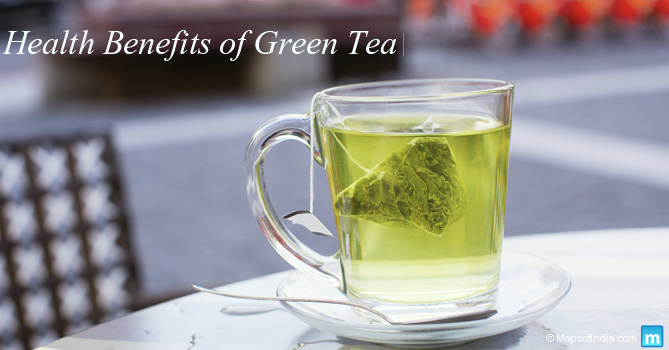While consuming too much of tea and coffee is considered bad for health because it increases your caffeine intake, there is one variant of tea that has been strongly encouraged for regular consumption at regular intervals. Yes, we are talking about Green Tea, the most sought-after beverage in today’s age. What makes green tea better than other teas and beverages?
We discuss below the benefits, properties, types and side effects of Green tea.
What is Green tea?
Green tea is prepared from the leaves of camellia sinensis, grown in China and Japan. The best quality of such tea is that the leaves undergo minimal oxidation during the processing and hence it is devoid of chemical substances and retains most of its healthy properties and ingredients.
Properties and Ingredients of Green tea
Green tea is loaded with anti-oxidant and anti-bacterial properties. The green tea leaves contain different enzymes, carbohydrates, dietary minerals, amino acids, bio-active compounds, lipids, sterols, related compounds, polyphenols, and flavanols which have their respective health benefits.
Health Benefits of Green Tea
Heart protection: The anti-oxidants in green tea help in reducing bad cholesterol, increasing good cholesterol, reducing blood pressure, and thereby help in protecting the heart. This was stated in a study made by Harvard Medical School’s Health Watch magazine.
Enhancement of Brain function: The caffeine content in green tea helps in improving brain functioning. Caffeine acts as a stimulant. The caffeine content in green tea is just sufficient enough to create a response without causing any side effects associated with too much caffeine. In various aspects of brain functioning, this property of green tea helps in improving mood, reaction time and memory. Along with caffeine, it also has the amino acid L-theanine, which is particularly efficient at improving brain function.
Weight loss: One of the main reasons for which green tea has become increasingly popular is its contribution towards weight loss. How? Well, green tea has been proven effective is boosting the metabolism of the body and increasing fat burning to a certain extent. The polyphenol found in green tea helps in burning fat.
Cancer prevention: Studies have also shown that consuming green tea on a regular basis can help in destroying the cancer cells in the body, without harming any health tissues around these cells. The anti-oxidants in green tea provide a protective barrier against the growth of cancer cells and prevent the body from various types of cancers: breast cancer, prostate cancer, colorectal cancer, etc.
Risk of Alzheimer’s and Parkinson’s lowered: The catechin compounds in green tea act upon the neurons in human brain cells and help in lowering the risk of Alzheimer’s and Parkinson’s diseases, which are commonly suffered by the elderly men and women.
Protection from Bacterial infections: Green tea can protect the body from infections caused by bacteria and viruses. The fluorine in green tea prevents tooth decay, beta-carotene present in green tea helps in the maintenance of the respiratory and the digestive systems, vitamin C helps in preventing cold and reducing fatigue.
Anti-ageing properties: Strange but true, if you drink green tea on a regular basis it will help you live longer. The reason is a no-brainer: it protects you from various diseases. A cup of green tea rejuvenates your body, making you feel fresh and active to start the day.
Types of Green Tea
The two main countries producing green tea are China and Japan. Accordingly, we have Chinese green tea and Japanese green tea. Both the varieties have their sub-varieties. There are green teas classified on the basis of prices. The three most popular tea in the medium price range are gunpowder green tea, bancha green tea and china green tea. Some of the popular ones at the higher price range are sencha green tea, matcha green tea, gyokuro green tea, etc.
Both organic and inorganic green teas are available in India. The most popular brands in the market are Tetley, Organic India, Twinings, Lipton, Taj Mahal, Mittal’s, etc. These are also available in flavours like ginger, honey, lemon, etc.
Side effects of Green Tea
There are certain side effects associated with green tea:
Pregnancy and breast feeding: Green tea is usually not advised to be taken by pregnant women and lactating mothers.
Iron deficiency: Green tea may aggravate anaemia and iron deficiency.
Side effect of caffeine: Though the caffeine content in green tea is much less than in coffee, yet we cannot altogether ignore the bad effects of caffeine. Drinking plenty of green tea daily (more than five times) can lead to:
- Insomnia
- Stomach upset
- Nausea
- Irregular heartbeat
- Anxiety disorder
- Glaucoma
- Bleeding disorder
- Frequent urination in some people
Green tea may also have negative reaction with some medicine
In spite of the side effects, there is no denying the fact that green tea is one of the most healthiest drinks or beverages that one could consume on a regular basis.
Read Also:
Organ Donation in India
Health & Fitness Gadgets
Hepatitis B in India: Guidelines for Prevention, Symptoms, Causes, Risks & Treatment
Amendments Proposed in Anti-smoking Law in India
The 10 Ways to Quit Smoking
How Useful are E-cigarettes?
Tobacco – The Leading Cause of Illnesses
How to Stay Healthy During Monsoons? Do’s and Don’ts
Japanese Encephalitis in India – Guidelines for Prevention, Control & Symptoms
Swine Flu Continues to Ravage India
Ebola Virus Outbreak – Is India Prepared?
India To Be Certified As A Polio-free Nation By WHO
Non-Communicable Diseases – Take Care, Before It’s Late
Swine Flu: What You Need to Know and Do
Prevention of Heart Attack and Other Related Heart Diseases
Leprosy – Causes, preventions and eradication programme
Prevalence of Diabetes in India
Can Delhi Handle an Ebola Outbreak
The Fever : Vaccination Still An Elusive Proposal
A Reality Check on State of Mental Health in India
Sharp rise in non polio Acute Flaccid Paralysis after polio-free status
How to Prevent Hair Loss in 10 Tested Ways?





